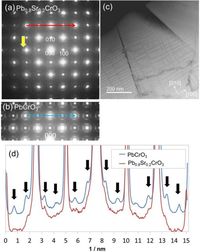In a pivotal study released on March 18, 2025, researchers have made significant strides in understanding the complex behavior of lead-based materials, particularly focusing on lead chromate (PbCrO3) and how its properties can be modified through strontium substitution. These findings shed light on lead's dual valency and its implications for future material design, especially considering lead's toxic profile and the need for safe alternatives.
The researchers, including K. Kurushima and H. Nakajima, utilized advanced high-resolution transmission electron microscopy (STEM) combined with elemental mapping techniques to gain insights into the role of lead ions exhibiting different valence states—specifically, Pb2+ and Pb4+—within the structure of Sr-substituted PbCrO3. This study specifically reports on the compound Pb0.8Sr0.2CrO3, where strontium ions (Sr2+) are found to occupy a well-defined lattice arrangement, while the lead ions display notable positional distortions.
The exploration of how lead ions behave in these materials is anchored in their unique electronic properties. "The lone pair electrons of s orbitals are responsible for the local lattice distortion," wrote the authors of the article. This distortion is crucial as it can affect the material's overall physiological attributes, an aspect indispensable for various applications, including catalysis and ferroelectricity.
The researchers confirmed through simulations that the substitutive placement of Sr2+ effectively reduces the presence of Pb2+ ions with inactive lone pair electrons. The study concluded that the structural integrity of Pb0.8Sr0.2CrO3 is preserved, characterized by a mixture of crystalline and amorphous regions similar to those found in standard PbCrO3 samples.
Moreover, their findings hinted at a more complicated underlying behavior linked to diffuse scattering phenomena, which was shown to be influenced by the valence states of the Pb ions. Specifically, the research team remarked that these behaviors resemble those of ferroelectric materials, further emphasizing the significance of lone pair electrons in driving the structural flexibility and functions of perovskite oxides.
Throughout the study, high-resolution atomic-resolution energy-dispersive X-ray spectroscopy (EDS) effectively mapped the positions of Sr and Pb ions. The outcomes indicated that Pb2+ ions, characterized by their lone pair electrons, predominantly display off-center positioning, while Pb4+ ions maintain a stable lattice position. This finding reinforces the study's assertion that the distribution of Pb ions under the influence of strontium substitution is essential for understanding the local structural origins of the observed diffuse scattering. The study proposes a model that enables researchers to estimate the distribution of Pb2+ and Pb4+ ions more accurately.
This in-depth analysis comprehensively highlights the exploration of microstructural features in materials that exhibit valence skipping behavior. The research proposes that the understanding of how these configurations influence physical properties can help propel the development of lead-free alternatives with high performance, significantly impacting material science.
In conclusion, while the exploration of lead-based materials like PbCrO3 continues to unravel fascinating insights, the importance of addressing lead's toxicity cannot be understated. This clarifies the necessity of ongoing research aimed at both understanding these complex behaviors and minimizing the reliance on lead-containing materials in the development of next-generation functional devices.




